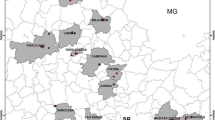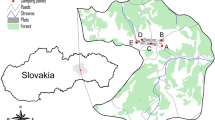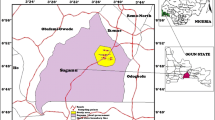Abstract
The investigation conducted in the Vojvodina Province, as a typical European and one of the biggest agricultural regions in the Balkans, offers the research methodology that could be used for any non/flooded agricultural region. The flood impact on heavy elements (HE) content in the flooded arable soil (n = 16) in relation to the control soil (n = 16) was examined, as well as their accumulation in the most often cultivated vegetables (n = 96) in the studied area. Results revealed that the flood did not significantly change the pseudo total HEs concentration in the soil as well as their amounts accumulated in different soil fractions. In both soils, only the average content of Ni exceeded the maximum permissible values set by Serbian soil quality standard which is in line with the Dutch standard. In comparison with the background values, notable enrichment is found for most of analyzed elements in both soils. Soil pollution status was assessed through several indices indicating that contamination range was in the domain from a moderate to a highly polluted. The principal component analysis demonstrated that soil contamination was probably originated from agricultural/anthropogenic activities (Cd, Cu, As, Pb), apart from Ni, Cr, and Co which came from natural weathering of the parent material. Carcinogenic and non-carcinogenic risks of selected HEs for Serbian population in the investigated region were below the threshold values. The average levels of Pb in investigated potato and carrot samples were higher than the maximum allowable concentrations established by EU/Serbian regulation. The total hazard quotients (THQ) of HEs through intake of analyzed vegetables were below the safe threshold (˂ 1), suggesting the absence of adverse health effects.




Similar content being viewed by others
Data availability
All data generated or analyzed during this study are included in this published article (and its supplementary information files).
References
Abbasi AM, Iqbal J, Khan MA, Shah MH (2013) Health risk assessment and multivariate apportionment of trace metals in wild leafy vegetables from Lesser Himalayas. Pak. Ecotoxicol Environ Saf 92:237–244
Acosta JA, Faz CA, Arocena JM, Debela F, Martinez-Martinez S (2009) Distribution of metals in soil particle size fractions and its implication to risk assessment of playgrounds in Murcia City (Spain). Geoderma 149:101–109
Adamo P, Arienzo M, Bianco MR, Terribile F, Violante P (2002) Heavy metal contamination of the soils used for stocking raw materials in the former ILVA iron steel industrial plant of Bagnoli (southern Italy). Sci Total Environ 295:17–34
Baltas H, Sirin M, Gökbayrak E, Ozcelik AE (2020) A case study on pollution and a human health risk assessment of heavy metals in agricultural soils around Sinop province, Turkey. Chemosphere 241:125015
Barać N, Škrivanj S, Bukumirić Z, Živojinović D, Manojlović D, Barać M, Petrović R, Ćorac A (2016) Distribution and mobility of heavy elements in floodplain agricultural soils along the Ibar River (Southern Serbia and Northern Kosovo). Chemometric investigation of pollutant sources and ecological risk assessment. Environ Sci Pollut Res 23:9000–9011
Dach L, Starmans D (2005) Heavy metals balance in Polish and Dutch agronomy: actual state and previsions for the future. Agric Ecosyst Environ 107:309–316
Dragović S, Mihailović N, Gajić B (2008) Heavy metals in soils: distribution, relationship with soil characteristics and radionuclides and multivariate assessment of contamination sources. Chemosphere 72:491–495
Epstein L, Bassein S (2001) Pesticide application of copper on perennial crops in California, 1993 to 1998. J Environ Qual 22:335–348
European Commission Regulation (2006) Commission regulation 1881/2006 of 19 December setting maximum levels for certain contaminants in foodstuffs. Off J Eur Union L 364:5–24
Facchinelli A, Sacchi E, Mallen L (2001) Multivariate statistical and GIS based approach to identify heavy metal sources in soil. Environ Pollut 114:313–324
Fei X, Xiao R, Christakos G, Langousis A, Ren Z, Tian Y, Lv X (2019) Comprehensive assessment and source apportionment of heavy metals in Shanghai agricultural soils with different fertility levels. Ecol Indic 106:105508
Fryer M, Collins CD, Ferrier H, Colvile RN, Nieuwenhuijsen MJ (2006) Human exposure modelling for chemical risk assessment: a review of current approaches and research and policy implications. Environ Sci Pol 9:261–274
Ghosh M, Singh SP (2005) A comparative study of cadmium phytoextraction by accumulator and weed species. Environ Pollut 133:365–371
Hakanson L (1980) An ecological risk index for aquatic pollution control. A sedimentological approach. Water Res 14:975–1001
Hu X, Zhang Y, Ding Z, Wang T, Lian H, Sun Y, Wu J (2012) Bioaccessibility and health risk of arsenic and heavy metals (Cd, Co, Cr, Cu, Ni, Pb, Zn and Mn) in TSP and PM2. 5 in Nanjing, China. Atmos Environ 57:146–152
Huang J, Huang R, Jiao JJ, Chen K (2007) Speciation and mobility of heavy metals in mud in coastal reclamation areas in Shenzhen, China. Environ Geol 53:221–228
Imperato M, Adamo P, Naimo D, Arienzo M, Stanzione D, Violante P (2003) Spatial distribution of heavy metals in urban soils of Naples city (Italy). Environ Pollut124: 247–256
Jiang Y, Chao S, Liu J, Yang Y, Chen Y, Zhang A, Cao H (2017) Source apportionment and health risk assessment of heavy metals in soil for a township in Jiangsu Province, China. Chemosphere 168:1658–1668
Jiang F, Ren B, Hursthouse A, Deng R, Wang Z (2019) Distribution, source identification, and ecological-health risks of potentially toxic elements (PTEs) in soil of thallium mine area (southwestern Guizhou, China). Environ Sci Pollut Res 26:16556–16567
Kabata-Pendias A, Mukherjee AB (2007) Trace elements from soil to human. Springer Science & Business Media
Karim Z, Qureshi BA, Mumtaz M (2015) Geochemical baseline determination and pollution assessment of heavy metals in urban soils of Karachi. Pakistan Ecol Indic 48(48):358–364
Kaur M, Kumar A, Mehra R, Mishra R (2018) Human health risk assessment from exposure of heavy metals in soil samples of Jammu district of Jammu and Kashmir. India Arab J Geosci 11
Khan K, Lu Y, Khan H, Ishtiaq M, Khan S, Waqas M, Wei L, Wang T (2013) Heavy metals in agricultural soils and crops and human health risks in Swat District, northern Pakistan. Food Chem Toxicol 58:449–458
Li LQ, Pan GX, Zhang PJ, Gong W (2001) Distribution of heavy metals in particle size fractions of major paddy soils in the Tai Lake region, China and the response to soil environmental change. Acta Scientia Circumstantiae 21:607–612
Li YB, Duanp ZW, Liu GL, Kalla P, Scheidt D, Cai Y (2015) Evaluation of the possible sources and controlling factors of toxic metals/metalloids in the Florida everglades and their potential risk of exposure. Environ Sci Technol 49:9714–9723
Mahanta JM, Bhattacharyya GK (2011) Total concentration, fractionation and mobility of heavy metals in soils of urban area of Guwahati, India. Environ Monit Assess 173:221–240
Marjanović DM, Vukčević MM, Antonović GD, Dimitrijević SI, Jovanović MD, Matavulj MM, Ristić DM (2009) Heavy metals concentration in soils from parks and green areas in Belgrade. J Serb Chem Soc 74:697–706
Marković M, Cupać S, Ðurović R, Milinović J, Kljajić P (2010) Assessment of heavy metal and pesticide levels in soil and plant products from agricultural area of Belgrade, Serbia. Arch Environ Contam Toxicol 58:341–351
Marrugo-Negretea J, Pinedo-Hernándeza J, Díez S (2017) Assessment of heavy metal pollution, spatial distribution and origin in agricultural soils along the Sinú River Basin, Colombia. Environ Res 154:380–388
Meng W, Wang Z, Hua B, Wang Z, Li H, Goodman RC (2016) Heavy metals in soil and plants after long-term sewage irrigation at Tianjin China: a case study assessment. Agr Water Manage 171:153–161
Milinović J, Lukić V, Nikolić-Mandić S, Stojanović D (2008) Concentrations of heavy metals in NPK fertilizers imported in Serbia. Pestic Phytomed (Belgrade) 23:195–200
Mitrović B, Vranješ B, Kostić O, Perović V, Mitrović M, Pavlović P (2019) Presence of radionuclides and toxic elements in feedstuffs and food of animal origin. Vet GL 73(1):30–39
Müller G (1969) Index of geoaccumulation in sediments of the Rhine River. Geol J 2:108–118
Nannoni F, Protano G, Riccobono F (2011) Fractionation and geochemical mobility of heavy elements in soils of a mining area in northern Kosovo. Geoderma 161:63–73
Ogunkunule CO, Fatoba PO (2013) Pollution loads and the ecological risk assessment of soil heavy metals around a mega cement factory in southwest Nigeria. Pol J Environ Stud 22:487–493
Pajević S, Arsenov D, Nikolić N, Borišev M, Orčić D, Župunski M, Mimica-Dukić N (2018) Heavy metal accumulation in vegetable species and health risk assessment in Serbia. Environ Monit Assess 190:459
Pandey J, Pandey U (2009) Accumulation of heavy metals in dietary vegetables and cultivated soil horizon in organic farming system in relation to atmospheric deposition in a seasonally dry tropical region of India. Environ Monit Assess 148:61–74
Peng CY, Zhu XH, Hou RY, Ge GF, Hua RM, Wan XC, Cai HM (2018) Aluminum and heavy metal accumulation in tea leaves: an interplay of environmental and plant factors and an assessment of exposure risks to consumers. J Food Sci 83(4):1165–1172
Pérez F, Llorca M, Köck-Schulmeyer M, Škrbić BD, Oliveira LS, Martinello KDB, Al-Dhabi NA, Antić I, Farréa M, Barceló D (2014) Assessment of perfluoroalkyl substances in food items at global scale. Environ Res 135:181–189
Rivera MB, Giraldez MI, Fernandez-Caliani JC (2016) Assessing the environmental availability of heavy metals in geogenically contaminated soils of the Sierra de Aracena Natural Park (SWSpain). Is there a health risk? Sci Total Environ 560-561:254–265
Rodríguez Martín JA, Ramos-Miras JJ, Boluda R, Gil C (2013) Spatial relations of heavy metals in arable and greenhouse soils of a Mediterranean environment region, (Spain). Geoderma 200:180–188
Rulebook on limit values of pollutants, harmful and hazardous substances in soil, Official Gazette of Republic of Serbia, No. 30/2018
Sakan S, Gržetić I, Đorđević D (2007) Distribution and fractionation of heavy metals in the Tisa (Tisza) River sediments. Env Sci Pollut Res 14(4):229–236
Serbian regulation (2019) Maximum allowed contents of contaminants in food and feed In: Official Bulletin of the Republic of Serbia 18/19: 12–16
Sharma BB, Sarma HP (2018) Assessment of heavy metal pollution in a Himalayan river using multivariate statistical tools: a case study of the Kameng River in Arunachal Pradesh, India. Arab J Geosci 11:308
Škrbić B, Đurišić-Mladenović N (2013) Distribution of heavy elements in urban and rural surface soils: the Novi Sad city and the surrounding settlements, Serbia. Environ Monit Assess185: 457–471
Škrbić B, Buljovčić M, Jovanović G, Antić I (2018) Seasonal, spatial variations and risk assessment of heavy elements in street dust from Novi Sad, Serbia. Chemosphere 205:452–462
SORS (2014) Agriculture Census, 2012. SORS, Belgrade
Statistical Office of the Republic of Serbia (2020) https://www.stat.gov.rs/en-us/oblasti/poljoprivreda-sumarstvo-i-ribarstvo/popis-poljoprivrede/ (accessed April 2020)
Sungur A, Soylak M, Ozcan H (2015) Investigation of heavy metal mobility and availability by the BCR sequential extraction procedure: relationship between soil properties and heavy metals availability. Chem Spec Bioavailab 26(4):219–230
Tessier A, Campbell PGC, Bisson M (1979) Sequential extraction procedure for the speciation of particulate trace metals. Anal Chem 51:844–851
Tian K, Huang B, Xing Z, Hu W (2017) Geochemical baseline establishment and ecological risk evaluation of heavy metals in greenhouse soils from Dongtai, China. Ecol Indic 72:510–520
Ubavić M, Bogdanović D, Hadžić V (1993) Basic chemical properties of soil of the Vojvodina province and possibilities of their contamination with heavy metals. Contemp Agric 1:47–51
USEPA (1989) Risk assessment guidance for superfund. Human health evaluation manual (part a), Interium Final, Vol. 1. United States Environmental Protection Agency, office of Emergency and Remedial Response: Washington, DC (EPA/540/1e98/002), 1989
USEPA (1997) Exposure factors handbook. United States Environmental Protection Agency, Office of Research and Development: Washington, DC (EPA/600/P-95/002Fa), 1997
USEPA (2001) Risk assessment guidance for superfund. Part a, Process for conducting probabilistic risk assessment, 20460, Vol. 3. United States Environmental Protection Agency, Office of Emergency and Remedial Response: Washington, DC (EPA 540-R-02e002), 2001
USEPA (2003) Child-specific exposure factors handbook (interium report), in N.C.F.E.A. Office of Research and Development, Washington Office: Washington, DC, 2003
USEPA (2008) Child-specific exposure factors handbook in N.C.F.E.A. Office of Research and Development, Washington Office: Washington, DC, 2008
USEPA (2011) Screening levels (RSL) for chemical contaminants at superfund sites. U.S. Environmental Protection Agency: Arlington, VA, United States, 2011
USEPA (2014) Code of Federal Regulations: priority pollutants list. Visited: 2016-7-5. Available at: https://www.gpo.gov/fdsys/pkg/CFR-2014-title40-vol29/xml/CFR- 2014-title40-vol29-part423-appA.xml
Wang XS, Qin Y (2007) Some characteristics of the distribution of heavy metals in urban topsoil of Xuzhou, China. Environ. Geochem Hlth 29:11–19
Wang F, Guan Q, Tian J, Lin J, Yang Y, Yang L, Pan N (2020) Contamination characteristics, source apportionment, and health risk assessment of heavy metals in agricultural soil in the Hexi Corridor. Catena 191:104573
Wu Y, Zhang H, Liu G, Zhang J, Wang J, Yu Y, Lu S (2016) Concentrations and health risk assessment of trace elements in animal-derived food in southern China. Chemosphere 144:564–570
Yadav I, Devi NL, Singh VK, Li J, Zhang G (2019) Spatial distribution, source analysis, and health risk assessment of heavy metals contamination in house dust and surface soil from four major cities of Nepal. Chemosphere 218:1100–1113
Živančev J, Ji Y, Škrbić B, Buljovčić M (2019) Occurrence of heavy elements in street dust from sub/urban zone of Tianjin: pollution characteristics and health risk assessment. J Environ Sci Heal A 54(10):999–1010
Acknowledgments
The results presented here are obtained within the projects no. 114-451-2044/2016-03 and 451-03-68/2020-14/200134 supported by the Secretariat for higher education and scientific research of the Province of Vojvodina and Ministry of Education, Science and Technological Development (451-03-68/2020-14/ 200134), respectively.
Funding
The research was financial supported by Secretariat for higher education and scientific research of the Province of Vojvodina (no. 114-451-2044/2016-03) and Ministry of Education, Science and Technological Development (451-03-68/2020-14/200134).
Author information
Authors and Affiliations
Contributions
Conceptualization, Biljana Škrbić; methodology, Jelena Živančev; formal analysis and investigation, Igor Antić and Maja Buljovčić; writing (original draft preparation), Jelena Živančev; writing (review and editing), Jelena Živančev and Biljana Škrbić; funding acquisition, Biljana Škrbić and Jelena Živančev; resources, Biljana Škrbić and Igor Antić; and supervision, Biljana Škrbić
All authors contributed to the study conception and design. All authors read and approved the final manuscript.
Corresponding author
Ethics declarations
Competing interests
The authors declare that they have no competing interests.
Ethical approval
Not applicable.
Consent to participate
Not applicable.
Consent to publish
All authors consent to the publication of the manuscript.
Additional information
Responsible Editor: Elena Maestri
Publisher’s note
Springer Nature remains neutral with regard to jurisdictional claims in published maps and institutional affiliations.
Supplementary information
ESM 1
(DOCX 1420 kb)
Rights and permissions
About this article
Cite this article
Škrbić, B.D., Živančev, J., Antić, I. et al. Pollution status and health risk caused by heavy elements in the flooded soil and vegetables from typical agricultural region in Vojvodina Province, Serbia. Environ Sci Pollut Res 28, 16065–16080 (2021). https://doi.org/10.1007/s11356-020-11794-w
Received:
Accepted:
Published:
Issue Date:
DOI: https://doi.org/10.1007/s11356-020-11794-w




